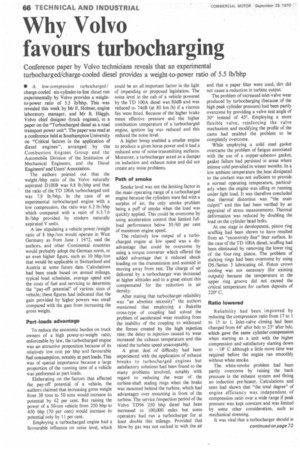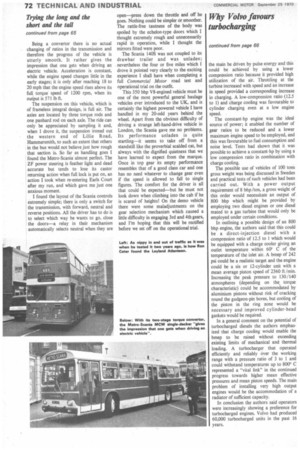Why. Volvo favours turbocharging
Page 68

Page 74

If you've noticed an error in this article please click here to report it so we can fix it.
Conference paper by Volvo technicians reveals that an experimental turbocharged/charge-cooled diesel provides a weight-to-power ratio of 5.5 lb/bhp
• A low-compression turbocharged / charge-cooled six-cylinder-in-line diesel run experimentally by Volvo provides a weightto-power ratio of 5.5 lb/bhp. This was revealed this week by Mr E. Holmer, engine laboratory manager, and Mr B. flaggh, Volvo chief designer (truck engines), in a paper on the "Turbocharged diesel as a road transport power unit". The paper was read at a conference held at Southampton University on "Critical factors in the application of diesel engines", arranged . by the Combustion Engines Group and the Automobile Division of the Institution of Mechanical Engineers, and the Diesel Engineers' and Users' Association.
The authors pointed out that the weight /bhp ratio of the Volvo naturally aspirated D1OOB was 9.8 lb/bhp and that the ratio of the TD 100A turbocharged unit was 7.9 lb/bhp. In the case of an experimental turbocharged engine with a low compression, the ratio was 6.2 lb /bhp which compared with a ratio of 6.3-7.6 lb /bhp provided by modern naturally aspirated V units.
A law stipulating a vehicle power /weight ratio of 8 bhp /ton would operate in West Germany as from June 1 1972, said the authors, and other Continental countries would probably adopt the German norm, or an even higher figure, such as 10 bhp/tort that would be applicable in Switzerland and Austria at some future date. Calculations had been made based on annual mileage, typical load schedules, average speed and the costs of fuel and servicing to determine the "pay-off potential" of various sizes of vehicle; these figures had indicated that the gain provided by higher powers was small compared with the gain from increasing the gross weight.
Part-loads advantage To reduce the economic burden on truck owners of a high power-to-weight ratio, enforceable by law, the turbocharged engine was an attractive proposition because of its relatively low cost per bhp and favourable fuel consumption, notably at part loads. This was of special importance because a large proportion of the running time of a vehicle was performed at part loads.
Elaborating on the factors that affected the pay-off potential of a vehicle, the authors claimed that increasing gross weight from 38 tons to 50 tons would increase its potential by 62 per cent. But raising the power of a 50-ton vehicle from 250 bhp to 430 bhp (70 per cent) would increase its potential only by 11 per cent.
Employing a turbocharged engine had a favourable influence on noise level, which could be an all-important factor in the light of impending or proposed legislation. The noise level in the cab of a vehicle powered by the TD 100A diesel was 80dB and was reduced to 74dB (at 80 km /h) if a viscous fan were fitted. Because of the higher brake mean effective pressure and the higher combustion temperature of a turbocharged engine, ignition lag was reduced and this reduced the noise level.
A higher bmep enabled a smaller engine to produce a given horse power and it had a reduced area of noise-transmitting surfaces. Moreover, a turbocharger acted as a damper on induction and exhaust noise and did not create any noise problems.
Path of smoke Smoke level was not the limiting factor in the main operating range of a turbocharged engine because the cylinders were fed with a surplus of air, the only smoke problem being a puff of smoke when the load was quickly applied. This could be overcome by using acceleration control that limited fullload performance below 50/60 per cent of maximum engine speed.
The relatively low output of a turbocharged engine at low speed was a disadvantage that could be overcome by using a torque converter which offered the added advantage that it reduced shock loading on the transmission and assisted in moving away from rest. The charge of air delivered by a turbocharger was increased at higher altitudes and to a great extent this compensated for the reduction in air density.
After stating that turbocharger reliability was "an absolute necessity" the authors mentioned that employing a Bakelite cross-type of coupling had solved the problem of accelerated wear resulting from the inability of the coupling to withstand the forces created by the high injection rate; the delay in injection caused by wear increased the exhaust temperature and this raised the turbine speed unacceptably.
A great deal of difficulty had been experienced with the application of exhaust breaks to turbocharged engines but satisfactory solutions had been found to the many problems involved, notably with regard to reducing the wear of the turbine-shaft sealing rings when the brake was mounted behind the turbine, which had advantages over mounting in front of the turbine. The service /inspection period of the Volvo TD96 250 bhp diesel had been increased to 100,000 miles but some operators had run a turbocharger for at least double this mileage. Provided that blow-by gas was not sucked in with the air and that a paper filter were used, dirt did not cause a reduction in turbine output.
The problem of increased inlet-valve wear produced by turbocharging (because of the high peak cylinder pressure) had been partly overcome by providing a valve-seat angle of 30° instead of 450. Employing a more flexible valve, reinforcing the valve mechanism and modifying the profile of the cams had enabled the problem to be completely overcome.
While employing a solid steel gasket overcame the problem of fatigue associated with the use of a copper-asbestos gasket, gasket failure had persisted in areas where intense cold prevailed in winter months. In a low ambient temperature the heat dissipated to the coolant was not sufficient to provide a normal operating temperature, particularly when the engine was idling or running under light load. It was therefore concluded that thermal distortion was "the main culprit" and this had been verified by an appraisal of stress measurements. Thermal deformation was reduced by doubling the load on the cylinder head bolts.
At one stage in development, piston ring scuffing had been shown to have resulted from an "excessively fine" liner surface. In the case of the TD 100A diesel, scuffing had been eliminated by removing the lower ring of the four-ring piston. The problem of sticking rings had been overcome by using DS /Series 3 lubricating oil. Piston crown cooling was not necessary (for existing outputs) because the temperature in the upper ring groove did not exceed the critical temperature for carbon deposits of 220° C.
Ratio lowered
Reliability had been improved by reducing the compression ratio from 17 to 1 to 15 to 1. Inlet-valve closing had been changed from 44° after bdc to 23° after bdc, which gave the same cylinder compression when starting as a unit with the higher compression and satisfactory starting down to —18 C although a little more time was required before the engine ran smoothly without white smoke.
The white-smoke problem had been partly overcome by raising the back pressure in the exhaust system and fitting an induction pre-heater. Calculations and tests had shown that "the total degree" of engine efficiency was independent of compression ratio over a wide range if peak pressure was kept constant and was limited by some other consideration, such as mechanical stressing.
It was vital that a turbocharger should in continued on page 72 the main be driven by pulse energy and this could be achieved by using a lower compression ratio because it provided high utilization of the air. Throttling at the turbine increased with speed and an increase in speed provided a corresponding increase in charging. A low-compression ratio (12.5 to 1) and charge cooling was favourable to cylinder charging even at a low engine speed.
The constant-hp engine was the ideal source of power; it enabled the number of gear ratios to be reduced and a lower maximum engine speed to be employed, and this was favourable to fuel consumption and noise level. Tests had shown that it was possible to achieve a constant-hp by using a low compression ratio in combination with charge cooling.
The possible use of vehicles of 100 tons gross weight was being discussed in Sweden and practical tests of such vehicles had been carried out. With a power output requirement of 8 bhp/ton, a gross weight of this order would necessitate an output of 800 bhp which might be provided by employing two diesel engines or one diesel mated to a gas turbine that would only be employed under certain conditions.
In outlining a possible design of an 800 bhp engine, the authors said that this could be a direct-injection diesel with a compression ratio of 12.5 to 1 which would be equipped with a charge cooler giving an outlet temperature within 60 C of the temperature of the inlet air. A bmep of 242 psi could be a realistic target and the engine could be a six or 12-cylinder unit with a mean average piston speed of 2360 ft/min. Increasing the peak pressure to 130/140 atmospheres (depending on the torque characteristic) could be accommodated by aluminium pistons without risk of cracking round the gudgeon-pin bores, but coOling of the piston in the ring zone would be necessary and improved cylinder-head gaskets would be required.
In a general comment on the potential of turbocharged diesels the authors emphasized that charge cooling would enable the bmep to be raised without exceeding existing limits of mechanical and thermal loading. A turbocharger that operated efficiently and reliably over the working range with a pressure ratio of 3 to 1 and could withstand temperatures up to 800° C represented a "vital link" in the continued progress towards higher mean effective pressures and mean piston speeds. The main problem of installing very high output engines would be the accommodation of a radiator of sufficient capacity.
In conclusion the authors said operators were increasingly showing a preference for turbocharged engines. Volvo had produced 60,000 turbocharged units in the past 16 years.


























































































































































































